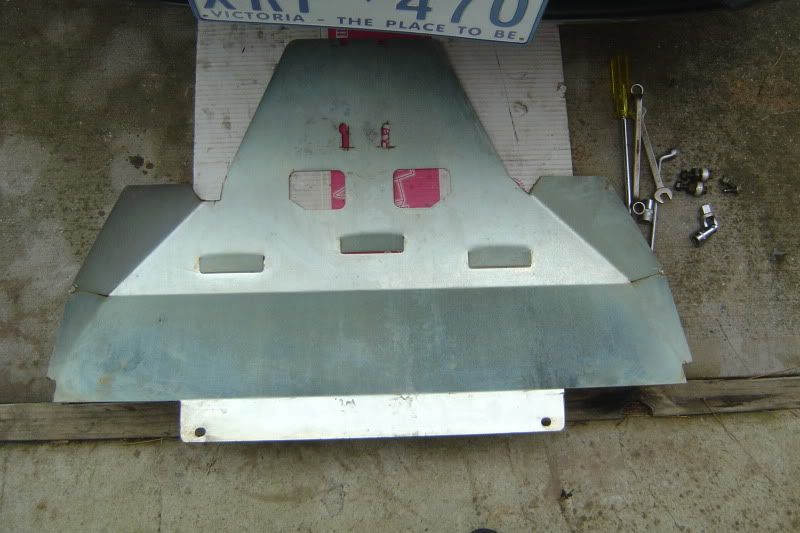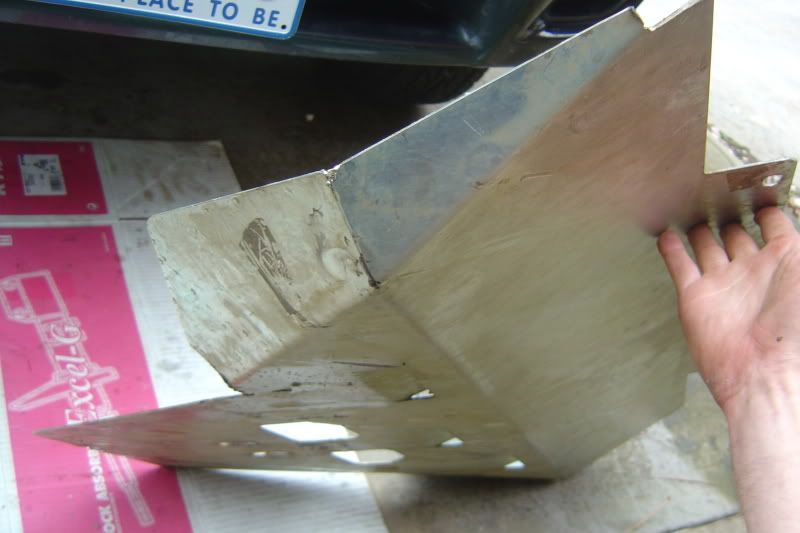Ratbag
Administrator
- Joined
- Jan 1, 2012
- Messages
- 7,483
- Location
- Bayside, Melbourne, Vic
- Car Year
- MY06, MY10
- Car Model
- Forester SG & SH
- Transmission
- 5MT/DR & 4EAT Sports
Gidday Shiv
I was surprised at how well the OEM polycarbonate guard stood up to it! Other than "pouting" (the front edge somehow ended up underneath the trailing edge of the bumper. Now, I wonder how that could have happened ... :rotfl: ). It appears that I might have to remove and refit one of the front retainers where it obviously took a direct hit.
From NL's report on the damage to his cast alloy sump guard (prior to this day trip), I think I would rather go down the drawn alloy or steel route for this guard.
Steel would be easier to have fabricated, and has far greater tensile strength than alloy. From previous experience with sump guards on most of my BMC FWD vehicles, the guard would not weigh all that much, regardless of material. If steel, it would need to be 3~4 mm plate; alloy would probably need to be 6~7 mms.
Weight data here for steel:
https://www.mascotsteel.com.au/Files/datasheets/sheetplate_steeldata.pdf
and an Excel calculator for a variety of materials is available from Atlas Steels here:
https://www.atlassteels.com.au/site/pages/product-weight-calculator.php
The existing OEM guard is about 1,000 x 500 mms - 0.5 m^2. The extension to protect the gearbox would be about 200 (W) x 500 (L). This would be welded onto the front part of the guard in such a way that the removable section of the front guard would form a flat surface front to rear.
The total area would be approx 0.75 m^2, and weight for 3 mm steel would be approx 0.75 x 23.55 kgs/m^2 = 17.66 kgs as against 6 mm aluminium at about 12 kgs. I would not think that this difference would be hugely significant
I have a design in mind, with welded front and rear side flanges, with a relatively narrow rear flange extending back to the rear gearbox mounting cross-member. This would slope upwards towards the rear, helping to prevent the trailing edge of the main part of the guard from hanging up if reversing over something, or rolling backwards. Have the trailing edge of the main guard cut at an angle towards the side/front of the plate (vehicle) for the same reason.
Otherwise the design would be almost a copy of the existing OEM guard, other than having a longer front (about 10~15 mms would do the trick, I reckon), so that the trailing edge on the bumper could not ride up over it the way mine did on this trip.
The flange mounting brackets would be welded, then drilled and bolted.
There is the removable section in the OEM guard for access to the oil drain and filter. I would copy that, cutting a similar hole in the plate, with bolts holding the removable plate in position. These would also have the heads facing groundwards, with the nuts welded onto the upper surface of the main body of the guard itself. Design the removable plate so that it was out of the way on the edges; i.e. wrapped upwards, particularly at the front and sides. Make sure that the bolts welded to the upper surface of the guard were not in a position to hit anything if the guard were to be really bashed upwards. A large piece of vibration pad could be attached to any areas of the upper surface where this was likely to occur.
As to fabrication, maybe I could try some local trailer manufacturers for a start?
Just some thoughts on this topic.
Anyone who wants to, please feel free to contribute your thoughts as well. All suggestions are more than welcome.
Terrific trip report lads, thanks for sharing
It certainly seems like that will be one of the most memorable trips you'll ever complete. Even the best of us can unintentionally find ourselves in sticky situations like that, testing both car and driver. Just glad you got out of it relatively unscathed.
Just looking at that clay road makes me shudder to think that some of you were driving it on standard highway tyres. A good set of all terrains and a proper sump guard is an excellent investment.
I was surprised at how well the OEM polycarbonate guard stood up to it! Other than "pouting" (the front edge somehow ended up underneath the trailing edge of the bumper. Now, I wonder how that could have happened ... :rotfl: ). It appears that I might have to remove and refit one of the front retainers where it obviously took a direct hit.
From NL's report on the damage to his cast alloy sump guard (prior to this day trip), I think I would rather go down the drawn alloy or steel route for this guard.
Steel would be easier to have fabricated, and has far greater tensile strength than alloy. From previous experience with sump guards on most of my BMC FWD vehicles, the guard would not weigh all that much, regardless of material. If steel, it would need to be 3~4 mm plate; alloy would probably need to be 6~7 mms.
Weight data here for steel:
https://www.mascotsteel.com.au/Files/datasheets/sheetplate_steeldata.pdf
and an Excel calculator for a variety of materials is available from Atlas Steels here:
https://www.atlassteels.com.au/site/pages/product-weight-calculator.php
The existing OEM guard is about 1,000 x 500 mms - 0.5 m^2. The extension to protect the gearbox would be about 200 (W) x 500 (L). This would be welded onto the front part of the guard in such a way that the removable section of the front guard would form a flat surface front to rear.
The total area would be approx 0.75 m^2, and weight for 3 mm steel would be approx 0.75 x 23.55 kgs/m^2 = 17.66 kgs as against 6 mm aluminium at about 12 kgs. I would not think that this difference would be hugely significant
I have a design in mind, with welded front and rear side flanges, with a relatively narrow rear flange extending back to the rear gearbox mounting cross-member. This would slope upwards towards the rear, helping to prevent the trailing edge of the main part of the guard from hanging up if reversing over something, or rolling backwards. Have the trailing edge of the main guard cut at an angle towards the side/front of the plate (vehicle) for the same reason.
Otherwise the design would be almost a copy of the existing OEM guard, other than having a longer front (about 10~15 mms would do the trick, I reckon), so that the trailing edge on the bumper could not ride up over it the way mine did on this trip.
The flange mounting brackets would be welded, then drilled and bolted.
There is the removable section in the OEM guard for access to the oil drain and filter. I would copy that, cutting a similar hole in the plate, with bolts holding the removable plate in position. These would also have the heads facing groundwards, with the nuts welded onto the upper surface of the main body of the guard itself. Design the removable plate so that it was out of the way on the edges; i.e. wrapped upwards, particularly at the front and sides. Make sure that the bolts welded to the upper surface of the guard were not in a position to hit anything if the guard were to be really bashed upwards. A large piece of vibration pad could be attached to any areas of the upper surface where this was likely to occur.
As to fabrication, maybe I could try some local trailer manufacturers for a start?
Just some thoughts on this topic.
Anyone who wants to, please feel free to contribute your thoughts as well. All suggestions are more than welcome.










